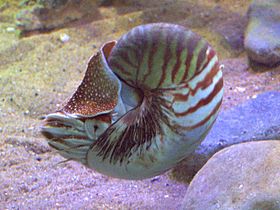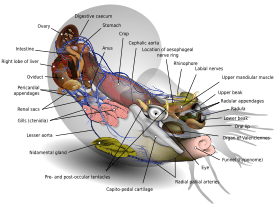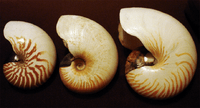Nautilus facts for kids
Quick facts for kids Nautilus |
|
|---|---|
 |
|
| Chambered nautilus: Nautilus pompilius | |
| Scientific classification | |
| Kingdom: | |
| Phylum: | |
| Class: | |
| Subclass: | |
| Order: |
Nautilida
|
| Family: |
Nautilidae
Blainville, 1825
|
| Genera | |
|
Allonautilus |
|
Imagine a creature that looks like it swam straight out of prehistoric times! That's the Nautilus, a special type of sea animal called a cephalopod. They are the only living members of a group called Nautiloidea. What's amazing is that they haven't changed much in millions of years, earning them the nickname 'living fossils'. You might also hear them called 'chambered nautiluses' because of their unique shells.
Scientists believe nautiluses are the only living relatives of the ancient ammonites, which lived during the Palaeozoic era.
There are currently six different kinds, or species, of nautilus alive today, belonging to two genera. The Nautilus pompilius, found near Western Australia, is the biggest and most famous. It can grow up to 27 centimeters (about 10.5 inches) wide! Most other nautiluses are smaller, usually less than 20 cm. The smallest is the Bellybutton nautilus, Nautilus macromphalus, which is only about 16 cm.
Nautiluses have a special tongue-like ribbon called a radula with nine teeth. They also have two pairs of gills to help them breathe underwater.
Contents
The Nautilus Shell
Nautiluses are the only cephalopods that have an external shell. This is a very old feature that their ancestors had. The animal can pull its entire body inside its shell for protection. It can then close the opening with a tough, leathery hood made from two special tentacles.
The shell is coiled and made of calcium carbonate, which is like chalk. The inside is lined with shiny mother-of-pearl. This shell is very strong and can handle a lot of pressure. However, it will break if the nautilus goes deeper than about 800 meters (2,600 feet).
The nautilus shell has two layers. The outside layer is a dull white, while the inner layer is a striking white with iridescence, meaning it shimmers with different colors. The very center of the shell is pearly and blue-gray. Sometimes, people make jewellery from this part of the shell, calling it an 'osmena pearl', but it's not a real pearl.
Shell Chambers and Buoyancy
The nautilus shell is divided into many small rooms, or chambers, inside. Each wall between these chambers is called a 'septum'. In the middle of each septum is a tube called a siphuncle. The nautilus uses this tube to change the air pressure in the chambers.
As the nautilus grows, its body moves forward in the shell. It then seals off the old chamber with a new wall. The last and largest chamber is where the animal lives. When a nautilus hatches, it has about four chambers. As an adult, it can have thirty or more!
Shell Camouflage
The color of the shell helps the nautilus stay hidden in the water. When you look down at a nautilus from above, its shell is darker and has stripes. This helps it blend in with the dark water below. The underside of the shell is almost completely white. This makes it hard to see the nautilus from below, as it blends with the brighter water near the ocean surface. This type of camouflage is called countershading.
The nautilus shell is also a beautiful example of a logarithmic spiral in nature.
How Nautiluses Live
Movement and Buoyancy
To swim, the nautilus pulls water into and pushes it out of its living chamber, using a method called jet propulsion. When water is inside the chamber, the siphuncle takes salt out of it and puts it into the nautilus's blood. When the water is pumped out, the animal changes its buoyancy using gas in the chambers.
By controlling the gas and fluid in its chambers with the siphuncle, the nautilus can float up or sink down. However, this way of controlling buoyancy means nautiluses cannot live in extremely deep water with very high pressure.
In the wild, nautiluses usually live at depths of about 300 meters (980 feet). At night, they often rise to around 100 meters (330 feet) to find food, mate, and lay eggs. As mentioned before, their shells cannot handle depths greater than about 800 meters (2,600 feet).

Diet and Senses
Nautiluses are predators, meaning they hunt other animals for food. They mainly eat shrimp, small fish, and crustaceans, which they catch with their many tentacles. Because they don't use much energy swimming, they only need to eat about once a month!
Unlike other cephalopods, nautiluses don't have very good eyesight. Their eyes are simple, like a pinhole camera, and water can pass through them. Instead of seeing well, they are thought to use their sense of smell (called olfaction) to find food and potential mates.
Evolution of Nautiluses
Fossil records show that nautiloids, the group that includes nautiluses, haven't changed much in their body shape for the last 500 million years. They were much more common and diverse about 200 million years ago. Many of the early nautiloids had straight shells, like the extinct Lituites.
Nautiloids first appeared in the Cambrian period and became important sea predators in the Ordovician period. Some ancient species grew to be over 2.5 meters (8 feet) long! The other main group of cephalopods, Coleoidea (which includes squids and octopuses), split off from the nautilus family a long time ago. The nautilus has stayed pretty much the same since then. Extinct relatives of the nautilus include the ammonites, which were very important for millions of years.
Reproduction and Life Cycle
Nautiluses are sexually dimorphic, meaning males and females look different. They reproduce by laying eggs. The eggs are attached to rocks in shallow waters and take a long time to develop—about twelve months! When they hatch, the baby nautiluses are around 30 millimeters (1.2 inches) long.
Female nautiluses can lay eggs once a year and then their reproductive organs grow back. This makes them the only cephalopods that can reproduce multiple times in their lives. Nautiluses have a very long lifespan for a cephalopod, living for about 20 years.
Where Nautiluses Live
Nautiluses are only found in the warm waters of the Indian and Pacific Oceans. You can find them between 30° North and 30° South latitude. They typically live on the deep slopes of coral reefs.
Images for kids
-
Hemishell showing the chambers in a logarithmic spiral
-
Head of N. pompilius showing the rudimentary eye, which functions similarly to a pinhole camera
-
Number of captured N. pompilius at various depths around the Osprey Reef Seamount, Coral Sea. The data was collected from 271 trapping events. Nautiluses were most common at 300 to 350 meters.
See also
 In Spanish: Nautilina para niños
In Spanish: Nautilina para niños


















